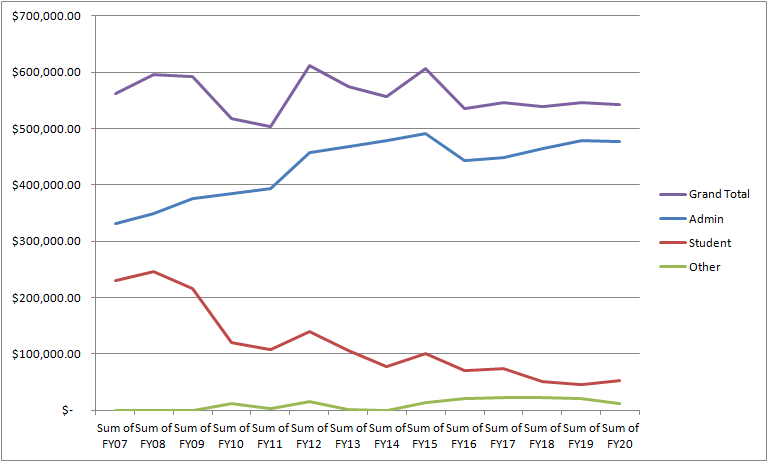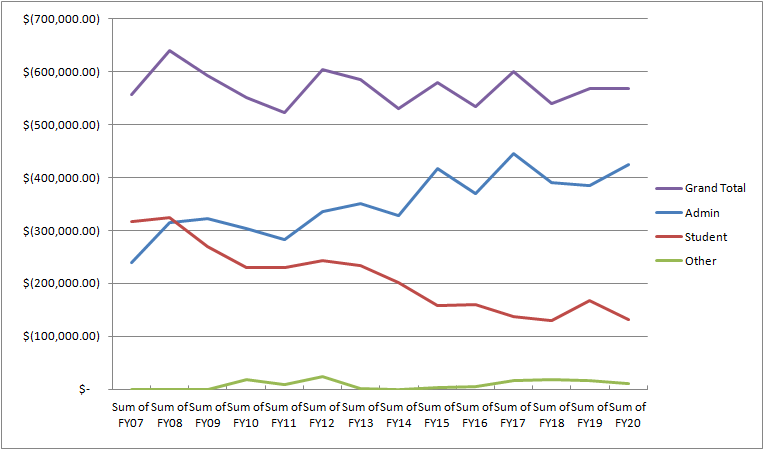In a time where Coronavirus-related measures have resulted in the largest percentage of people unemployed since the Great Recession, and it’s resultant negative impact on tax revenues, I’m making the argument that George Mason University Student Media’s budget should not be cut.
Why?
The short answer is that any significant cut to our budget will significantly, and most likely permanently, reduce student opportunities to express themselves. Given how small our budget is currently and how important our role is to the protection and exercise of students’ First Amendment rights, the University should make every effort to maintain our budget.
Our budget is a tiny fraction (0.046%) of the University’s $1.25 billion overall budget. Our actual cost to the University is actually less since 13.4% of our revenue is self-generated through activities like advertising and services.
Looking at our revenue over the past fourteen years (Figure 1 below), our overall revenue is lower now than it was fourteen years ago. Think of how many things have gone up in price since 2007. Wages have gone up. For example, the Federal Minimum Wage went up to $7.25/hr in 2009. And it’s going up to $9.50/hr in Virginia next year. Printing costs have gone up. Web hosting costs have gone up.
It’s also important to look up what makes up revenue. The biggest part of our revenue is the student fee transfer. The second biggest part is self generated revenue. As I mentioned above, self generated revenue is things like newspaper advertising, production services, journal submission fees and subscriptions. Unfortunately, since the Great Recession of 2007 – 2009, self generated revenue has been consistently trending downward. See the red line (third from the top) in Figure 1.
I’ve heard some administrators say that if Student Media needs more money, they should make more self generated revenue. This is pretty much out of our control. Unless you are Google, pretty much no one is making as much in advertising as they used to. I’d like to see those same administrators buck macro-economic trends. If you need more graduate students …
To be fair, the University was initially willing to invest in Student Media. However, there was a change in administration and the new regime took a hatchet to our student fee revenue, cutting it back to pre-2012 levels.
You can see the results of what I call the double-whammy, the student fee cuts and decline in advertising sales, in Figure 3 below.
In those fourteen years, we’ve cut the number of copies of the newspaper we print by a third and the number of literary journals we print by over 50%. Entire groups have disappeared, including Connect2Mason, an award-winning news website, and GMView, the yearbook (although lack of participation played a bigger role in killing the yearbook).
You might notice that the “Admin” line has grown. At first blush this may appear to be “administrative bloat“, but it’s not. First, the only part of our budget that has grown is professional staff salary, and only because it is mandated by the Commonwealth of Virginia as a “cost of living adjustment” (remember things cost more than fourteen years ago). Second, a lot of functions were centralized in an attempt to boost efficiency – functions like the advertising sales staff, web hosting and publication distribution.
Also, the University brought in high-priced consultants to look at staffing levels. They looked at the number of students we serve and what our peers spend on student media and concluded that we needed to be doubled in size immediately. Of course, no action was taken on that particular recommendation.
This shrinking of the amount we spend on student is something that bothers me greatly. We need to serve the students. It’s right there in the name, Student Media.
Any budget cuts fall disproportionately on the students since professional staff costs are essentially fixed.
At this point, after absorbing over a decade’s worth of cuts, there’s no more fat left to cut. If you’re only printing a few hundred copies of a journal, how much more can you cut before you have nothing? The most likely outcome of significant cuts is our smaller groups that have little to no self-generated revenue ceasing to exist, groups like Hispanic Culture Review, a Spanish-English journal covering Hispanic culture, and So to Speak, a journal covering feminist topics.
I would hate to stop supporting diverse voices, at a time where we need it more than ever.
I would hope that the University would find a few dollars (our budget is 0.046% remember, relative pocket change) somewhere to spare us deep cuts.
Unfortunately, it’s probably naive of me to thing that our University will suddenly start supporting us considering they didn’t when times where better. George Mason University record in protecting first amendment rights like freedom of the press or freedom of speech has not been spotless either.


